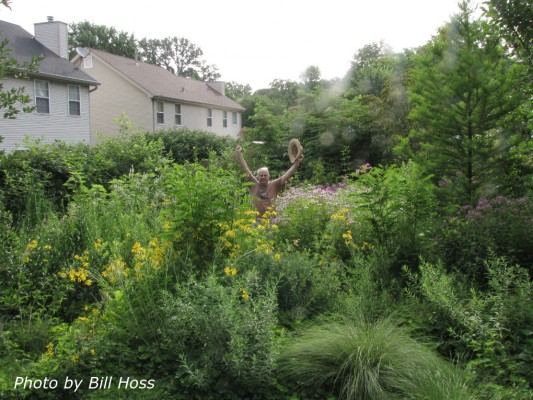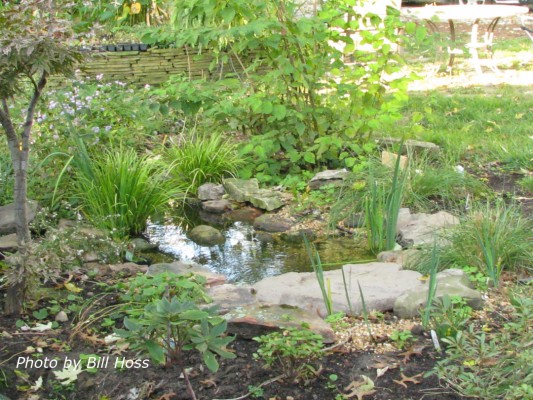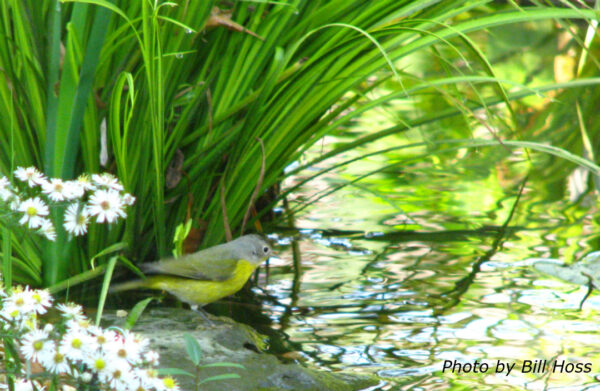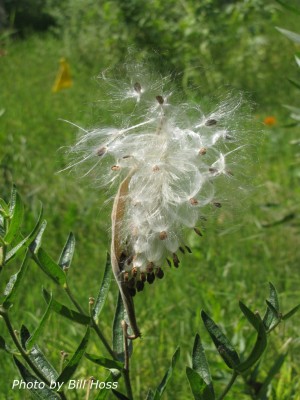By Peggy Whetzel
To go birding or to photograph wildlife, two of his favorite activities, Bill Hoss has only to step outside his white frame house on North Forest Avenue in Webster Groves.
From the street, just about the only hint that there’s something unusual about the 43 by 315-foot lot is the hairy-looking buffalo grass (Bouteloua dactyloides) and other low-growing natives replacing fescue just beyond the sidewalk.
But a short walk past the house and down the gravel driveway – and flanked by the neatly-mowed lawns of his neighbors – sits a back yard filled side-to-side and front-to-back with an estimated more than 100 species of native wildflowers, grasses, shrubs, and trees. And just a big toe or two off the driveway, a small stream bubbles through it.
Bill put the stream in himself. For birds and human visitors, the little stream “makes” the yard. Nashville, Tennessee and yellow-rumped warblers, grosbeaks, cedar waxwings, orioles, wrens, flickers, and many others have been drawn to the clear, moving water.
The yard’s appeal to wildlife is bolstered by native plants ranging from shady woodland flowers, shrubs, and trees around the stream to a meadow of native asters, monarda, and other sun-loving perennials growing where the family vegetable garden used to be. Bird talk and the sound of fluttering wings and rustling branches are as much a part of the garden as the landscaping.
Plant diversity is a hallmark of the yard. Some of the young trees and shrubs to be found include:
- witch hazel (Hamamelis vernalis),
- ninebark (Physocarpus opulifolius),
- filbert (Corylus americana),
- green hawthorn (Crataegus viridis), and
- buttonbush (Cephalanthus occidentalis).
Altogether, the yard supplies nectar for pollinators, caterpillar fodder for future butterflies, and, for birds, caterpillars and other insects, spiders, and berries to eat.

Garden phlox (Phlox paniculata), Joe pye weed (Eutrochium purpureum), and purple coneflower (Echinacea purpurea)
In the middle, and, all but hidden in the garden is Bill’s personal refuge, his office.
From inside, the sliding glass door gives the impression that the garden is in another room. And once, a wren flitted inside searching for spiders. “Nothing makes a wren happier than hunting spiders,” said Bill. And in the spring, flickers proclaim their territory by drumming on the metal chimney poking above the roof.
Bill’s office is where he pursues two of his lifelong interests. One of them is trains, both model trains and the real deal. He custom-makes model trains and buildings for clients.
Bill has lived in the house on Forest Avenue all his life. His grandfather worked for the Missouri Pacific. And, until a new subdivision blocked the view, he could see the trains running on the railroad tracks from his yard. In 1974, he founded the Missouri Pacific Historical Society. For nine years, he worked for the Museum of Transport. And he still rides trains when he can.
Bill’s other love is wild-life watching. A small window on the west wall of his office overlooks the garden. Bill, who has a BA in Fine Arts with an emphasis in photography, uses the window as a photographer’s blind, keeping a camera on a tripod poised to photograph birds making a splash in the little stream.
His interest in nature goes way back. “As a kid, I liked watching lines of ants,” he said. “I was always fascinated by insects, especially ants, bees, and butterflies.”
Besides birds, the stunning wildlife photos taken in his yard include butterflies, from newly-laid eggs to various instars (caterpillar growth stages) to chrysalis to flight. Species include sulphurs, swallowtails, monarchs, painted ladies, hairstreaks, fritillaries, and hummingbird sphinx moths.
His first experience with native plant gardening came about in 1952 when his mother drove to an area known as Rock Hollow to collect wildflowers, bringing Bill and his best friend along to help dig. (Bill had a lot of practice under his belt helping his dad hand-spade the vegetable garden.) The area was quite rural and wildflowers grew in profusion. They transplanted:
- ostrich ferns (Matteuccia struthiopteris),
- sensitive ferns (Onoclea sensibilis),
- blood root (Sanguinaria canadensis),
- Dutchman’s breeches (Dicentra cucullaria),
- trout lilies (Erythronium americanum), and
- bluebells (Mertensia virginica).
to their Webster Groves yard. Bluebells remain a favorite for Bill.
“In those days, no nurseries sold wildflowers,” said Bill. “If you wanted them you had to dig them yourself.” A few of the first spring wildflowers to emerge have been there since the 1950’s.
[Editor’s Note: While it used to be common practice to collect native plants from the wild, St. Louis Wild Ones discourages this practice, except in the case of plant rescues.]
But it wasn’t until he retired, Bill said, that he had time to do anything about his concern for the environment and protecting wildlife. He seems to have made up for lost time.
About seven or eight years ago, after becoming tired of mowing the lawn, Bill began intensively replacing his home turf with native plants. He became a Missouri Master Naturalist, which requires annual re-certification, and he takes part in the Cornell University bird feeder count every year. He has served as vice president and also as a board member of the St. Louis chapter of Wild Ones. And he’s on the Webster Groves Greenspace Advisory Commission, which this year produced an inspiring pamphlet with beautiful photos, “Guide to the Trees of Distinction in Webster Groves.”
In November, Bill, who is 70, wielded a chain saw, helping to clear bush honeysuckle from a park as one of the city’s Make A Difference Day projects.
And his wild yard, rated Platinum by the Audubon Society’s Bring Conservation Home program, was on the 2015 St. Louis Native Plant Garden Tour.
Just the same, Bill describes his gardening style, which packs in the maximum plant diversity a city lot can manage, as “functional” rather than “a showcase.”
“I’m nearly a gardener,” Bill said. “I like to release plants back into the wild and let them do their thing.”
[Not a valid template]






Beautiful pictures Bill. Great reporting Peggy. I am impressed.
Wow!
This is brilliant.Inspiring. I’m very glad you got talked into doing it.xN
Greatly admire what you have accomplished and Webster Groves is a wonderful place to live.
Any advice you care to offer for those of us who live in less receptive communities?
Thanks
Hi Linda,
I’ve been lucky. I have good neighbors on both sides of me who understand what I’m doing even if it isn’t exactly their cup of tea.
I think it’s important to have some sort of a formal border around any areas that the public can see. I’m using turf grass as a border in the front yard and along the sides of the yard. Look at the last photo with the rail fence. The actual property line is about 6′ to the right.
I’d also suggest trying to find your community’s weed ordinance and reading it over. Also considering talking to to the city department that is in charge of enforcing the ordinance. Here in Webster I talked to the inspector who didn’t know what Buffalo grass was and admitted he didn’t know anything about natives in general. He didn’t have a problem as long as I kept the edges “neat”. What I hadn’t noticed was that the grass, which is a running variety, had grown over the curbing and was heading across the street. A couple of minutes with a trimmer and he was happy. I now pay more attention.
If you haven’t done it, consider having a yard assessment from Bring Conservation Home. They should be able to help with planting ideas.
If I can be of any other help, let me know.
Thanks very much for taking time to reply and the suggestion of an assessment form “Bring Conservation Home”. I will contact them right away.
Thanks again.
Truly a work of beauty 🙂 Thanks so much for sharing it !!!
Just saw this, Bill! Great article and now I must see your new stream!